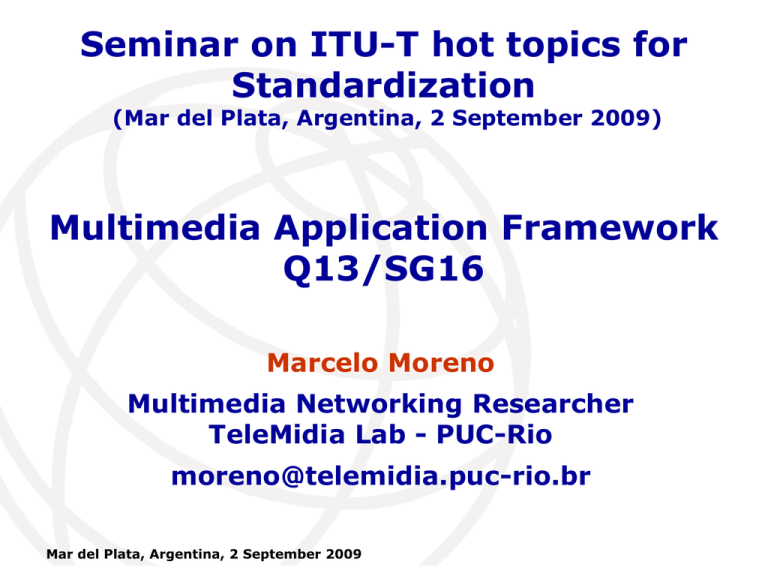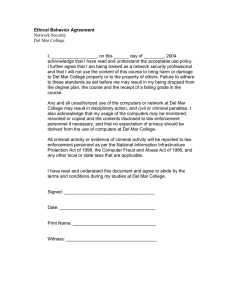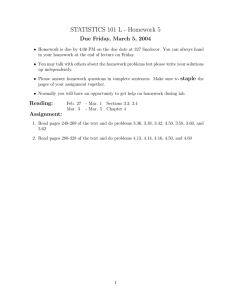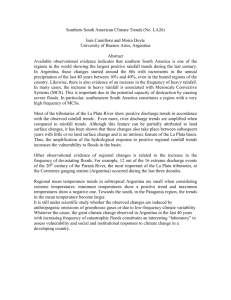Seminar on ITU-T hot topics for Standardization Multimedia Application Framework Q13/SG16
advertisement

Seminar on ITU-T hot topics for Standardization (Mar del Plata, Argentina, 2 September 2009) Multimedia Application Framework Q13/SG16 Marcelo Moreno Multimedia Networking Researcher TeleMidia Lab - PUC-Rio moreno@telemidia.puc-rio.br Mar del Plata, Argentina, 2 September 2009 International Telecommunication Union Introduction Multimedia Applications for IPTV Interactivity Services Games And more… Mar del Plata, Argentina, 2 September 2009 International Telecommunication Union 2 Introduction IPTV set-top boxes Multiple vendors Multiple platforms Multimedia Applications must be platform-independent Interoperability is mandatory Content creators/providers need a common application framework Mar del Plata, Argentina, 2 September 2009 International Telecommunication Union 3 H.IPTV-MAFR ITU-T’s effort to identify and harmonize the relevant multimedia application frameworks Established technologies New emerging technologies Question 13, Study Group 16 Multimedia application platforms and end systems for IPTV Mar del Plata, Argentina, 2 September 2009 International Telecommunication Union 4 H.IPTV-MAFR Set-top box vendors will be able to compete in multiple markets Migration between markets is supported choosing well-known MAFR standards Hybrid set-top boxes Component-based engines Configurable systems Content interchange Mar del Plata, Argentina, 2 September 2009 International Telecommunication Union 5 H.IPTV-MAFR MAFR can be classified by the authoring paradigm Declarative Application Frameworks e.g.: HTML, BML, SVG, NCL… Procedural Application Frameworks e.g.: Java (MHP)… 2 recommendations approved 13 working documents Mar del Plata, Argentina, 2 September 2009 International Telecommunication Union 6 H.760 (ex-H.IPTV-MAFR.0) H.760 - Overview of multimedia application frameworks for IPTV services Identifies and briefly describes the relevant standards of multimedia application frameworks Interoperability and harmonization in IPTV services Mar del Plata, Argentina, 2 September 2009 International Telecommunication Union 7 H.760 (Overview) Declarative application frameworks: BIFS, BML, CEA-2014, CSS, DOM, DVBHTML, EcmaScript, HTML, LASeR, MHEG-5, NCL, SVG, WTML Procedural application frameworks GEM-based frameworks, M3W Annex A describes common usage of web-related technologies (HTML, DOM, CSS, EcmaScript) Mar del Plata, Argentina, 2 September 2009 International Telecommunication Union 8 H.761 (ex-H.IPTV-MAFR.9) Nested Context Language (NCL) and Ginga-NCL for IPTV services NCL is a glue language that holds media together in a multimedia presentation, describing relationships among media objects in time and space XML-based, high-level constructs Ginga-NCL is an NCL presentation engine built as part of an IPTV middleware Mar del Plata, Argentina, 2 September 2009 International Telecommunication Union 9 H.761 (NCL) NCL highlights: Code reuse Multidevice support (in a home network) Content adaptability Spatiotemporal media synchronization No restrictions about media objects Procedural code handled as a media object. Native scripting in Lua Open-source reference implementation Mar del Plata, Argentina, 2 September 2009 International Telecommunication Union 10 H.IPTV-MAFR.1 Binary Format for Scene for IPTV Scene description language, a part of MPEG-4 standard. Designed to allow for the efficient representation of dynamic and interactive presentations Description of the spatial and temporal organization of the different scene components. Mar del Plata, Argentina, 2 September 2009 International Telecommunication Union 11 H.IPTV-MAFR.2 Broadcasting Markup Language for IPTV (BML) Declarative application specification for multimedia broadcasting in Japan Standardized by ARIB. BML consists of XHTML, CSS, Document Object Model (DOM) and ECMAScript. BML defines additional API and objects for IPTV using ECMAScript. Mar del Plata, Argentina, 2 September 2009 International Telecommunication Union 12 H.IPTV-MAFR.3 CEA-2014 for IPTV Remote User Interface specification Allows a user interface to be remotely displayed on devices. Based on existing web technologies XHTML, EcmaScript, CSS and DOM 2. It is a web based protocol and framework for Remote user interface (UI) on UPnP Home Network and over Internet. Mar del Plata, Argentina, 2 September 2009 International Telecommunication Union 13 H.IPTV-MAFR.4 Cascading Style Sheet for IPTV CSS is a Style sheet language by W3C Used to describe the presentation of a document written in a markup language. A CSS can be either linked to a document through a URI or included in the document. Does not constitute by itself a MAFR Mar del Plata, Argentina, 2 September 2009 International Telecommunication Union 14 H.IPTV-MAFR.5 Document Object Model for IPTV Platform-, language-neutral interface Allows programs and scripts to dynamically access and update the content and structure of documents. It does not constitute by itself multimedia framework but is used with some markup languages. Mar del Plata, Argentina, 2 September 2009 International Telecommunication Union 15 H.IPTV-MAFR.6 ECMAScript for IPTV Scripting language by ECMA Used on the Web and supported in many applications Included as a component in many presentation engines (PE) such as BML and DVB-HTML Mar del Plata, Argentina, 2 September 2009 International Telecommunication Union 16 H.IPTV-MAFR.7 LASeR and SAF for IPTV MPEG-4 Part 20, designed for representing and delivering rich-media services to resource-constrained devices It defines two binary formats: LASeR, a binary format for encoding 2D scenes; and SAF, a binary format for aggregating in a single stream LASeR content with audio/video streams. Mar del Plata, Argentina, 2 September 2009 International Telecommunication Union 17 H.IPTV-MAFR.8 MHEG-5 for IPTV Represents an application as a set of scenes based on synchronization and spatial-temporal relationships of multiple media formats It supports structural composition, event-action associations, navigation, and user interaction capabilities. Mar del Plata, Argentina, 2 September 2009 International Telecommunication Union 18 H.IPTV-MAFR.10 Scalable Vector Graphics for IPTV Describes 2D graphics and graphical applications in XML. Allows for three types of graphic objects: vector graphic shapes, images and text. Drawings can be interactive and dynamic. Animations can be defined and triggered either declaratively or via scripting Mar del Plata, Argentina, 2 September 2009 International Telecommunication Union 19 H.IPTV-MAFR.11 Worldwide TV Markup Language IPTV Content format for delivery using Internet Servers. Supports key features to enable serviceoriented applications. Platform comprises a micro-browser and a markup language (WML 1.3 spec). User agent behavior is more sophisticated than a standard internet based HTML browser. Mar del Plata, Argentina, 2 September 2009 International Telecommunication Union 20 H.IPTV-MAFR.12 MPEG Multimedia Middleware IPTV M3W Multimedia platform API defines mainly audio and video processing APIs handling front-end, decoders and postprocessing of A/V. M3W Multimedia APIs offer a high-level API that is independent of the target hardware. Focus on MPEG technologies. Mar del Plata, Argentina, 2 September 2009 International Telecommunication Union 21 H.IPTV-MAFR.13 HTML for IPTV Hypertext Markup Language XHTML DHTML HTML profile for IPTV Mar del Plata, Argentina, 2 September 2009 International Telecommunication Union 22 H.IPTV-MAFR.14 Lua for IPTV services Extension programming language to support procedural programming with data description facilities. Lua is intended to be used as a powerful, lightweight scripting language. Lua engine is small and easily portable to several hardware platforms. The Lua engine is distributed as free software under the MIT license. Mar del Plata, Argentina, 2 September 2009 International Telecommunication Union 23 Final Remarks Market is in serious need of standardized interoperable solutions. Interoperability will provide benefit for all and encourage growth of the multimedia application market. The H.760 recommendation series standardizes the relevant MAFR technologies. Mar del Plata, Argentina, 2 September 2009 International Telecommunication Union 24 Final Remarks Interoperability is achieved through configurable platforms that can be adapted to specific MAFR subsets. The use of standardized, mediaindependent glue language is also a good solution for interoperability and harmonization. MAFR discussions are under way in Q13/SG16, a highly active question. Mar del Plata, Argentina, 2 September 2009 International Telecommunication Union 25 Seminar on ITU-T hot topics for Standardization (Mar del Plata, Argentina, 2 September 2009) Thank you Marcelo Moreno Multimedia Networking Researcher TeleMidia Lab - PUC-Rio moreno@telemidia.puc-rio.br Mar del Plata, Argentina, 2 September 2009 International Telecommunication Union


